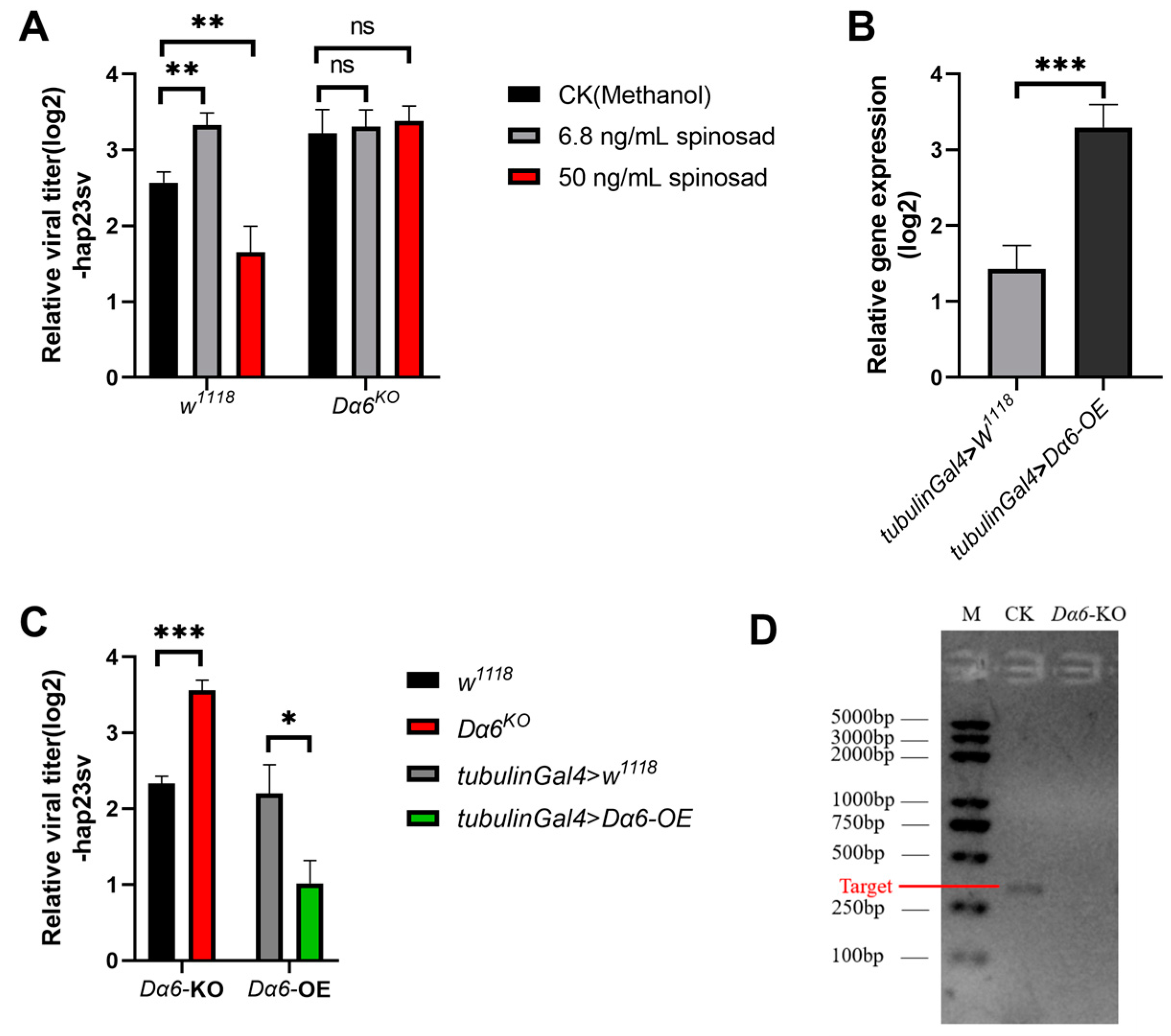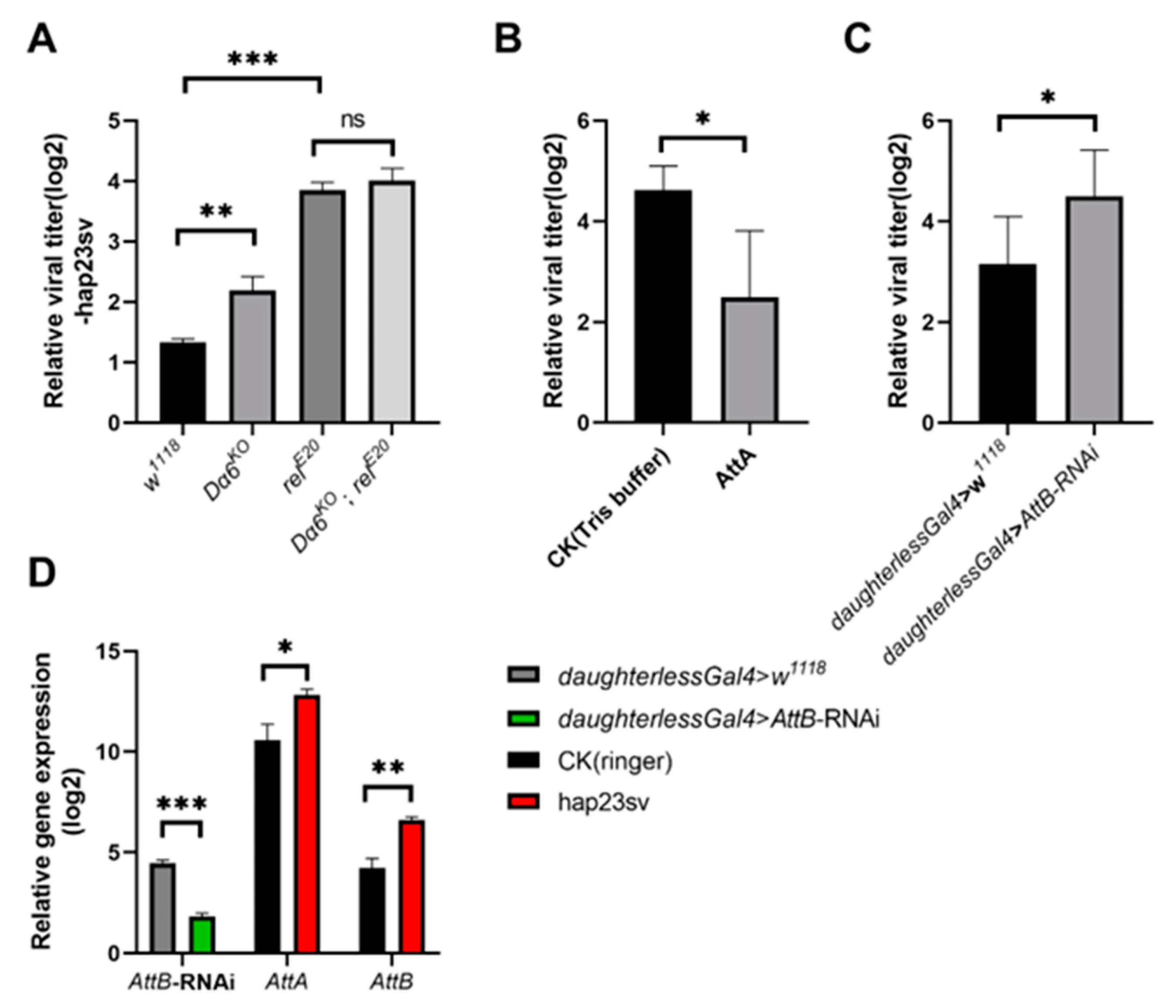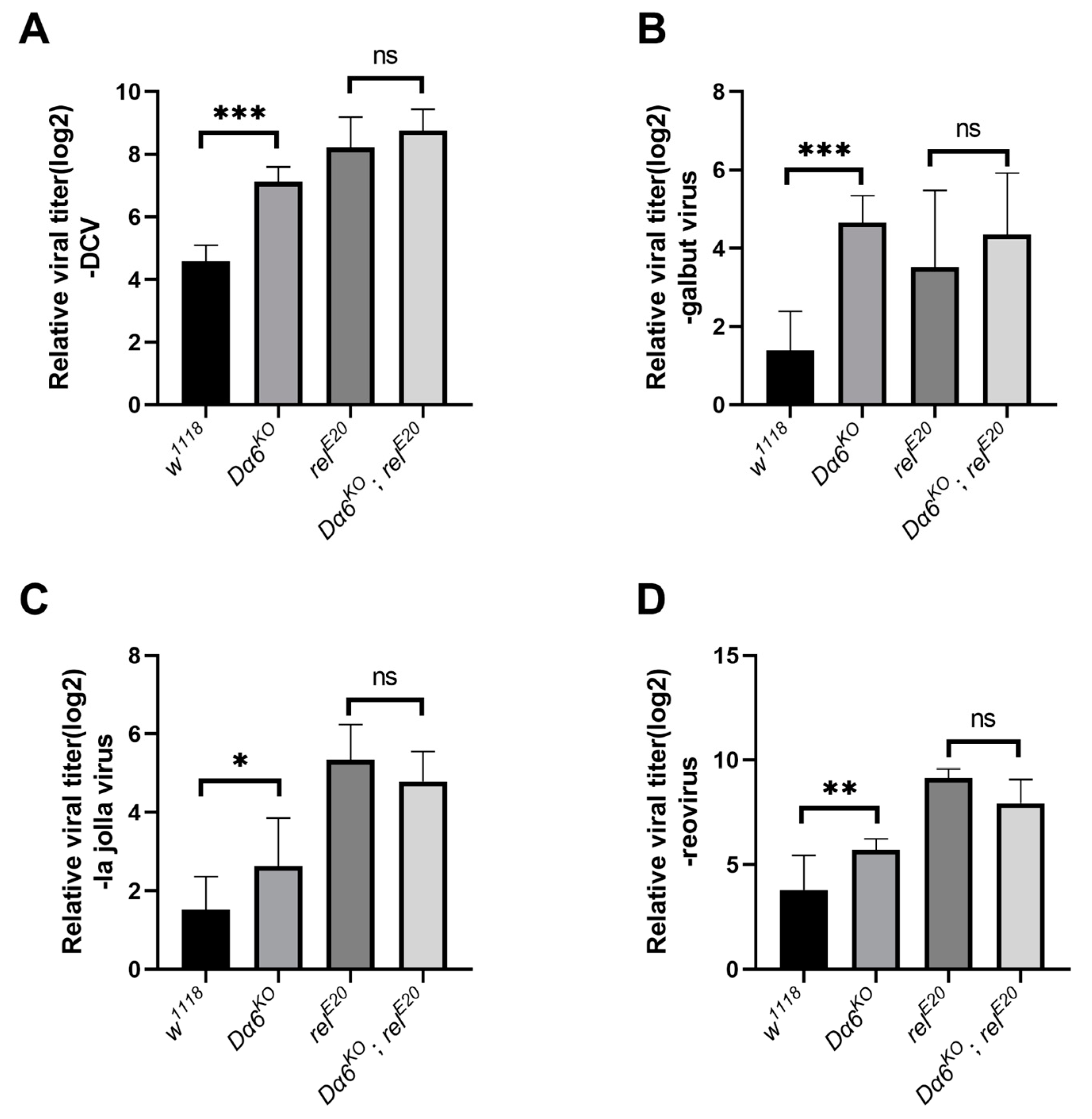Nicotinic Acetylcholine Receptor Alpha6 Contributes to Antiviral Immunity via IMD Pathway in Drosophila melanogaster
Abstract
1. Introduction
2. Materials and Methods
2.1. Flystocks
2.2. Virus Isolates
2.3. Immune Challenge of Adult Flies
2.4. Quantitative RT-PCR
2.5. Quantify the Bacterial Load
2.6. RNA-seq Analysis
2.7. Insecticide Dilution and Exposure
2.8. Effect of Antimicrobial Peptide AttA Provisioning on Viral Load
2.9. Statistical Analyses
3. Results
3.1. Spinosad and Its Target Dα6 Can Affect DMelSV Replication
3.2. Knockdown of Dα6 Negatively Regulates the Expression of IMD Pathway Genes
3.3. Dα6 Regulation of Host Immunity against DMelSV via IMD Pathway
3.4. Dα6 Plays a Role in a Broad Antiviral Immunity against Variety of RNA Viruses
3.5. Dα6 Does Not Contribute to Immunity to Bacteria or Fungi
4. Discussion
Supplementary Materials
Author Contributions
Funding
Institutional Review Board Statement
Informed Consent Statement
Data Availability Statement
Conflicts of Interest
References
- Crossthwaite, A.J.; Bigot, A.; Camblin, P.; Goodchild, J.; Lind, R.J.; Slater, R.; Maienfisch, P. The invertebrate pharmacology of insecticides acting at nicotinic acetylcholine receptors. J. Pestic. Sci. 2017, 42, 67–83. [Google Scholar] [CrossRef]
- Sparks, T.C.; Crossthwaite, A.J.; Nauen, R.; Banba, S.; Cordova, D.; Earley, F.; Ebbinghaus-Kintscher, U.; Fujioka, S.; Hirao, A.; Karmon, D.; et al. Insecticides, biologics and nematicides: Updates to IRAC’s mode of action classification—A tool for resistance management. Pestic. Biochem. Physiol. 2020, 167, 104587. [Google Scholar] [CrossRef] [PubMed]
- Diao, Q.; Li, B.; Zhao, H.; Wu, Y.; Guo, R.; Dai, P.; Chen, D.; Wang, Q.; Hou, C. Enhancement of chronic bee paralysis virus levels in honeybees acute exposed to imidacloprid: A Chinese case study. Sci. Total Environ. 2018, 630, 487–494. [Google Scholar] [CrossRef] [PubMed]
- Di Prisco, G.; Cavaliere, V.; Annoscia, D.; Varricchio, P.; Caprio, E.; Nazzi, F.; Gargiulo, G.; Pennacchio, F. Neonicotinoid clothianidin adversely affects insect immunity and promotes replication of a viral pathogen in honey bees. Proc. Natl. Acad. Sci. USA 2013, 110, 18466–18471. [Google Scholar] [CrossRef] [PubMed]
- Giordani, G.; Cattabriga, G.; Becchimanzi, A.; Di Lelio, I.; De Leva, G.; Gigliotti, S.; Pennacchio, F.; Gargiulo, G.; Cavaliere, V. Role of neuronal and non-neuronal acetylcholine signaling in Drosophila humoral immunity. Insect Biochem. Mol. Biol. 2023, 153, 103899. [Google Scholar] [CrossRef]
- Sansone, C.L.; Cohen, J.; Yasunaga, A.; Xu, J.; Osborn, G.; Subramanian, H.; Gold, B.; Buchon, N.; Cherry, S. Microbiota-Dependent Priming of Antiviral Intestinal Immunity in Drosophila. Cell Host Microbe 2015, 18, 571–581. [Google Scholar] [CrossRef]
- Huang, Z.; Kingsolver, M.B.; Avadhanula, V.; Hardy, R.W. An antiviral role for antimicrobial peptides during the arthropod response to alphavirus replication. J. Virol. 2013, 87, 4272–4280. [Google Scholar] [CrossRef]
- Longdon, B.; Murray, G.G.R.; Palmer, W.J.; Day, J.P.; Parker, D.J.; Welch, J.J.; Obbard, D.J.; Jiggins, F.M. The evolution, diversity, and host associations of rhabdoviruses. Virus Evol. 2015, 1, vev014. [Google Scholar] [CrossRef]
- Cao, C.; Wang, Z.; Shi, W. Research progress on the interaction between insects and rhabdoviruses. J. Plant Prot. 2020, 1, 1–10. [Google Scholar] [CrossRef]
- Deng, B.; Li, Q.; Liu, X.; Cao, Y.; Li, B.; Qian, Y.; Xu, R.; Mao, R.; Zhou, E.; Zhang, W.; et al. Chemoconnectomics: Mapping Chemical Transmission in Drosophila. Neuron 2019, 101, 876–893.e4. [Google Scholar] [CrossRef]
- Magwire, M.M.; Bayer, F.; Webster, C.L.; Cao, C.; Jiggins, F.M. Successive increases in the resistance of Drosophila to viral infection through a transposon insertion followed by a Duplication. PLoS Genet. 2011, 7, e1002337. [Google Scholar] [CrossRef] [PubMed]
- Webster, C.L.; Waldron, F.M.; Robertson, S.; Crowson, D.; Ferrari, G.; Quintana, J.F.; Brouqui, J.M.; Bayne, E.H.; Longdon, B.; Buck, A.H.; et al. The Discovery, Distribution, and Evolution of Viruses Associated with Drosophila melanogaster. PLoS Biol. 2015, 13, e1002210. [Google Scholar] [CrossRef] [PubMed]
- Longdon, B.; Fabian, D.K.; Hurst, G.D.D.; Jiggins, F.M. Male-killing Wolbachia do not protect Drosophila bifasciata against viral infection. BMC Microbiol. 2012, 12 (Suppl. S1), S8. [Google Scholar] [CrossRef] [PubMed]
- Cao, C.; Cogni, R.; Barbier, V.; Jiggins, F.M. Complex Coding and Regulatory Polymorphisms in a Restriction Factor Determine the Susceptibility of Drosophila to Viral Infection. Genetics 2017, 206, 2159–2173. [Google Scholar] [CrossRef] [PubMed]
- Tsai, C.W.; McGraw, E.A.; Ammar, E.D.; Dietzgen, R.G.; Hogenhout, S.A. Drosophila melanogaster Mounts a Unique Immune Response to the Rhabdovirus Sigma virus. Appl. Environ. Microbiol. 2008, 74, 3251–3256. [Google Scholar] [CrossRef] [PubMed]
- Kuo, T.H.; Handa, A.; Williams, J.A. Quantitative measurement of the immune response and sleep in Drosophila. J. Vis. Exp. 2012, 70, e4355. [Google Scholar] [CrossRef]
- Martelli, F.; Hernandes, N.H.; Zuo, Z.; Wang, J.; Wong, C.; Karagas, N.E.; Roessner, U.; Rupasinghe, T.; Robin, C.; Venkatachalam, K.; et al. Low doses of the organic insecticide spinosad trigger lysosomal defects, elevated ROS, lipid dysregulation, and neurodegeneration in flies. eLife 2022, 11, e73812. [Google Scholar] [CrossRef] [PubMed]
- Littleton, J.T.; Ganetzky, B. Ion channels and synaptic organization: Analysis of the Drosophila genome. Neuron 2000, 26, 35–43. [Google Scholar] [CrossRef] [PubMed]
- Jones, A.K.; Sattelle, D.B. Diversity of insect nicotinic acetylcholine receptor subunits. Adv. Exp. Med. Biol. 2010, 683, 25–43. [Google Scholar] [CrossRef]
- Embregts, C.; Begeman, L.; Voesenek, C.J.; Martina, B.; Koopmans, M.; Kuiken, T.; Geurtsvan Kessel, C.H. Street RABV Induces the Cholinergic Anti-inflammatory Pathway in Human Monocyte-Derived Macrophages by Binding to nAChR alpha7. Front. Immunol. 2021, 12, 622516. [Google Scholar] [CrossRef]
- Wu, S.C.; Liao, C.W.; Pan, R.L.; Juang, J.L. Infection-induced intestinal oxidative stress triggers organ-to-organ immunological communication in Drosophila. Cell Host Microbe 2012, 11, 410–417. [Google Scholar] [CrossRef]
- Van Rij, R.P.; Saleh, M.C.; Berry, B.; Foo, C.; Houk, A.; Antoniewski, C.; Andino, R. The RNA silencing endonuclease Argonaute 2 mediates specific antiviral immunity in Drosophila melanogaster. Genes Dev. 2006, 20, 2985–2995. [Google Scholar] [CrossRef] [PubMed]
- Galiana-Arnoux, D.; Dostert, C.; Schneemann, A.; Hoffmann, J.A.; Imler, J.L. Essential function in vivo for Dicer-2 in host defense against RNA viruses in drosophila. Nat. Immunol. 2006, 7, 590–597. [Google Scholar] [CrossRef] [PubMed]
- Rosendo Machado, S.; van der Most, T.; Miesen, P. Genetic determinants of antiviral immunity in dipteran insects—Compiling the experimental evidence. Dev. Comp. Immunol. 2021, 119, 104010. [Google Scholar] [CrossRef] [PubMed]
- Hanson, M.A.; Lemaitre, B. New insights on Drosophila antimicrobial peptide function in host defense and beyond. Curr. Opin. Immunol. 2020, 62, 22–30. [Google Scholar] [CrossRef] [PubMed]
- Feng, M.; Fei, S.; Xia, J.; Labropoulou, V.; Swevers, L.; Sun, J. Antimicrobial Peptides as Potential Antiviral Factors in Insect Antiviral Immune Response. Front. Immunol. 2020, 11, 573073. [Google Scholar] [CrossRef] [PubMed]
- Wachinger, M.; Kleinschmidt, A.; Winder, D.; von Pechmann, N.; Ludvigsen, A.; Neumann, M.; Holle, R.; Salmons, B.; Erfle, V.; Brack-Werner, R. Antimicrobial peptides melittin and cecropin inhibit replication of human immunodeficiency virus 1 by suppressing viral gene expression. J. Gen. Virol. 1998, 79, 731–740. [Google Scholar] [CrossRef] [PubMed]
- Luplertlop, N.; Surasombatpattana, P.; Patramool, S.; Dumas, E.; Wasinpiyamongkol, L.; Saune, L.; Hamel, R.; Bernard, E.; Sereno, D.; Thomas, F.; et al. Induction of a peptide with activity against a broad spectrum of pathogens in the Aedes aegypti salivary gland, following Infection with Dengue Virus. PLoS Pathog. 2011, 7, e1001252. [Google Scholar] [CrossRef] [PubMed]
- Li, F.; Li, M.; Wang, H.; Mao, T.; Chen, J.; Lu, Z.; Qu, J.; Fang, Y.; Li, B. Effects of phoxim pesticide on the immune system of silkworm midgut. Pestic. Biochem. Physiol. 2020, 164, 58–64. [Google Scholar] [CrossRef]
- Janssens, L.; Stoks, R. Exposure to a widespread non-pathogenic bacterium magnifies sublethal pesticide effects in the damselfly Enallagma cyathigerum: From the suborganismal level to fitness-related traits. Environ. Pollut. 2013, 177, 143–149. [Google Scholar] [CrossRef]
- Wang, L.; Pang, Z.; Chen, Q.; Song, Z.; Lu, Y.; Yang, M.; Huang, J.; Yu, X.Q.; Wang, X. Sublethal exposure to spinetoram impacts life history traits and dengue virus replication in Aedes aegypti. Insect Sci. 2023, 30, 486–500. [Google Scholar] [CrossRef] [PubMed]





| Gene Type | Stock ID | Source |
|---|---|---|
| w*; P{UAS-3xFLAG.dCas9.VPR} attP40; P{tubP-GAL4} LL7/T(2;3)TSTL14, SM5:TM6B, Tb1 | BL67048 | Bloomington Drosophila Stock Center, Bloomington, IN, USA |
| if/cyo; daughterlessGal4 | TB00153 | Tsinghua Stock Center, Beijing, China |
| Dα6KO | DRZ17-CG4128-1 | CCT related Drosophila line generated by Dr. Yi Rao’s Lab at Peking University, Beijing, China [10] |
| w1118 | V60000 | Vienna Drosophila Resource Center, Vienna, Austria |
| AttB-RNAi | V52342 | Vienna Drosophila Resource Center, Vienna, Austria |
| y1sc*v1sev21; P{TOE.GS01969}attP40 | BL80510 | Bloomington Drosophila Stock Center, Bloomington, IN, USA |
| y1sc*v1sev21; P{GS00089} attP40 | BL67539 | Bloomington Drosophila Stock Center, Bloomington, IN, USA |
| w1118; RelE20es | BL9457 | Bloomington Drosophila Stock Center, Bloomington, IN, USA |
| if/cyo; MKRS/TM6B, Tb | - | Obtained from Genetics Department, University of Cambridge, Cambridge, United Kingdom |
| - | 22a (DMelSV susceptible strain) | Obtained from Genetics Department, University of Cambridge, Cambridge, United Kingdom |
| Name | Sequence 5′→3′ |
|---|---|
| KO-α6-F1 | GCAATCGCATGAAGGAGCTG |
| KO-α6-R1 | CTATCCACAACCATTGCCGC |
| KO-REL-F1 | CCGAAAACCATGGAACTGCA |
| KO-REL-R1 | TAGCAACGCCGAAACTAACG |
| Name | Sequence 5′→3′ |
|---|---|
| RpL32 qRT-PCR F | TGCTAAGCTGTCGCACAAATGG |
| RpL32 qRT-PCR R | TGCGCTTGTTCGATCCG-TAAC |
| SIGMAV 1343F | ATGTAACTCGGGTGTGACAG |
| SIGMAV 1496R | CCTTCGTTCATCCTCCTGAG |
| Relish-qF | AACTAACTTGGACAGCCCACATTC |
| Relish-qR | TTTGCGTATGCCTCCCACACGGTTTC |
| Attacin A F | CAATGGCAGACAATCTGG |
| Attacin A R | ATTCCTGGGAAGTTGCTGTG |
| Attacin B F | ACAACAATGCTGGTCATGGTGCC |
| Attacin B R | ATGGGCCTCCTGCTGGAAGACA |
| Attacin C F | TTGGACAAGTGTTCGCAGCGGG |
| Attacin C R | TCCAGGCCGTGTCCATGATTGT |
| Attacin D F | GTCACTAGGGTTCCTCAG |
| Attacin D R | GCCGAAATCGGACTTG |
| imd-qF | TTCGGCTCCGTCTACAACTT |
| imd-qR | GTGATCGATTATGGCCTGGT |
| dredd-qF | ACATTGCCCTTCTCCACAGA |
| dredd-qR | CATGGCGATGCTGTTGGATG |
| DCV_qPCR_599_F | GACACTGCCTTTGATTAG |
| DCV_qPCR_733_R | CCCTCTGGGAACTAAATG |
| IflaB_qPCR_4F_928 | GCTCTGATATCCCGGCC |
| IflaB_qPCR_4R_1064 | GCAGCTTTTGAACCATATTGTG |
| Dmel-Reo 900F1 | AAGGGAAAGAGGCGGCTCGTAT |
| Dmel-Reo 900R1 | GTTGTTCTGGCGACGGCAGTT |
| pGal-but-qpcr-F1 | CGACAAGGAATACAGCATACCA |
| pGal-but-qpcr-R1 | CTTCATCAGCGGATTCAGCATA |
| nAChRα6qF | GTGGAACGACTACAATCTGCG |
| nAChRα6qR | AAGATACCAGGGGGCACGTA |
| Dcr-2-F | GCTTTTATGTGGGTGAACAGGG |
| Dcr-2-R | GGCTGTGCCAACAAGAACTT |
Disclaimer/Publisher’s Note: The statements, opinions and data contained in all publications are solely those of the individual author(s) and contributor(s) and not of MDPI and/or the editor(s). MDPI and/or the editor(s) disclaim responsibility for any injury to people or property resulting from any ideas, methods, instructions or products referred to in the content. |
© 2024 by the authors. Licensee MDPI, Basel, Switzerland. This article is an open access article distributed under the terms and conditions of the Creative Commons Attribution (CC BY) license (https://creativecommons.org/licenses/by/4.0/).
Share and Cite
Wang, Z.; Lin, X.; Shi, W.; Cao, C. Nicotinic Acetylcholine Receptor Alpha6 Contributes to Antiviral Immunity via IMD Pathway in Drosophila melanogaster. Viruses 2024, 16, 562. https://doi.org/10.3390/v16040562
Wang Z, Lin X, Shi W, Cao C. Nicotinic Acetylcholine Receptor Alpha6 Contributes to Antiviral Immunity via IMD Pathway in Drosophila melanogaster. Viruses. 2024; 16(4):562. https://doi.org/10.3390/v16040562
Chicago/Turabian StyleWang, Zhiying, Xiaoju Lin, Wangpeng Shi, and Chuan Cao. 2024. "Nicotinic Acetylcholine Receptor Alpha6 Contributes to Antiviral Immunity via IMD Pathway in Drosophila melanogaster" Viruses 16, no. 4: 562. https://doi.org/10.3390/v16040562
APA StyleWang, Z., Lin, X., Shi, W., & Cao, C. (2024). Nicotinic Acetylcholine Receptor Alpha6 Contributes to Antiviral Immunity via IMD Pathway in Drosophila melanogaster. Viruses, 16(4), 562. https://doi.org/10.3390/v16040562







